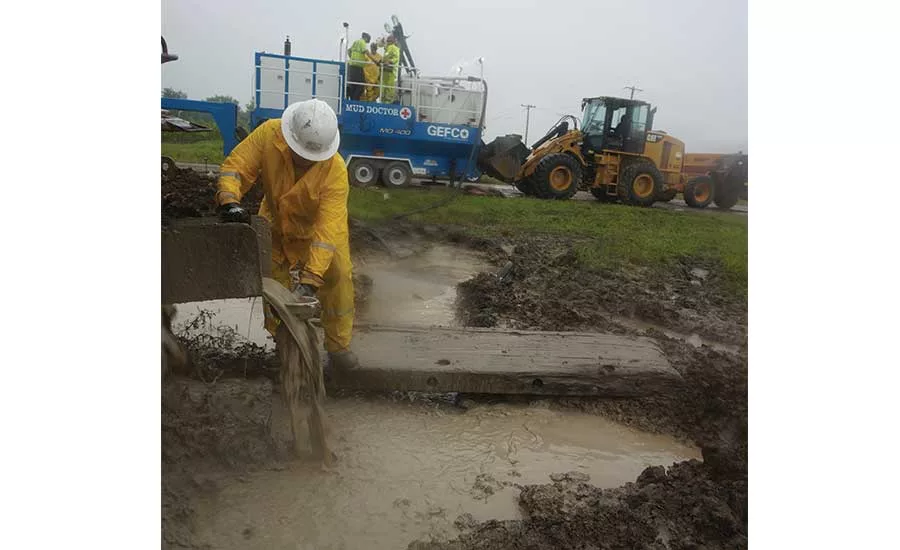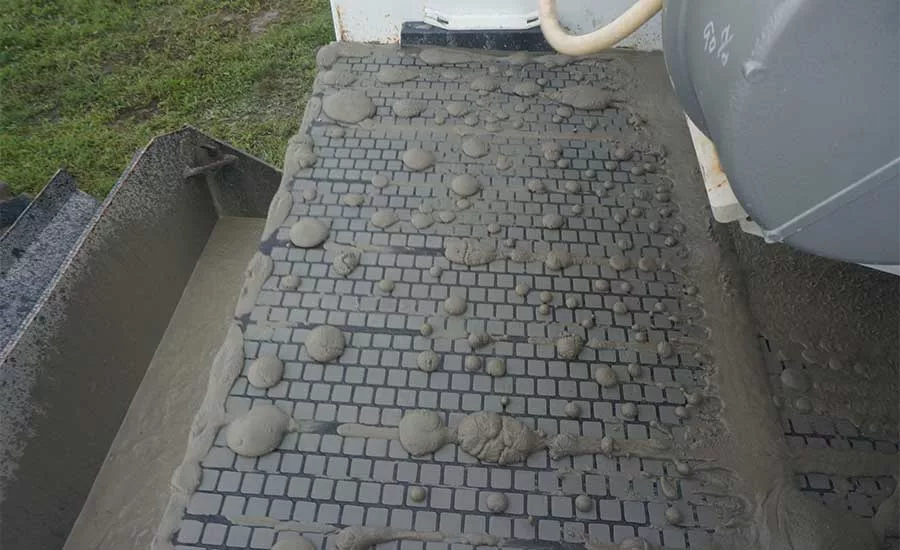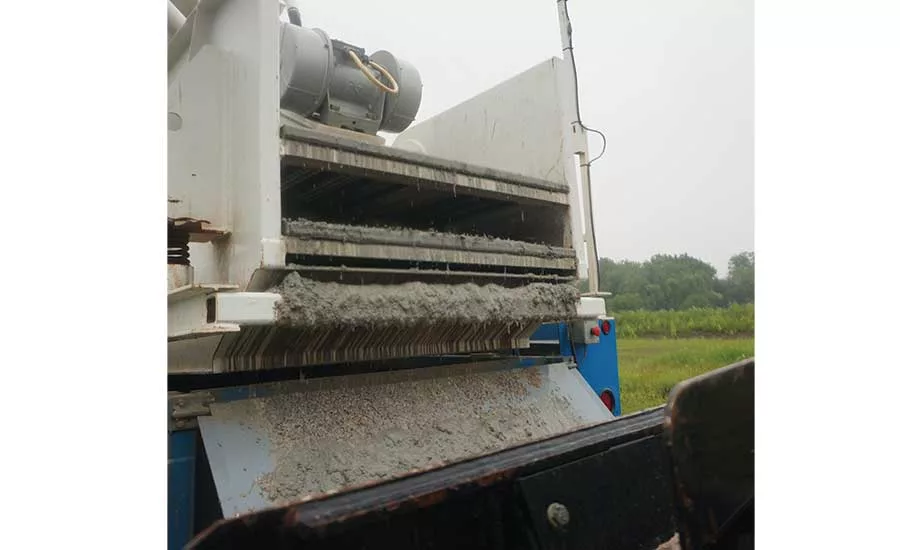Tips for Solids Control on Drilling Jobs

Whether you use a solids control unit or a mud pit, it’s not rocket science: Keep solids intact and get them to the surface, then deal with them before they head back downhole. Source: Brock Yordy photos

It’s important to match the capacity of a solids unit to the needs of the hole. A hole that requires 400 gpm of processing is going to overwhelm a 250-gpm solids unit pretty quickly.

If more fluid conveys off the unit than solids, it could be a sign of screen blinding. Source: Brock Yordy
Do you own a solids control unit or a very expensive mud pit on wheels? I ask this question because I encounter both on jobsites regularly. Not only do I see them in person, but I reply to calls and emails daily on cleaning issues. I love those calls and please, keep them coming. Throughout my career, I have worked on mud cleaners and solids control units in many diverse locations, from assisting Ortman Drilling on the first drilling phase of Ball State University’s geothermal project to wireline coring projects on both sides of the Atacama Desert, southern Peru and northern Chile. Regardless of the geographic location, the rule of solids control is always the same: Success to any method of solids control is achieved when cuttings are kept intact from bit to surface. I believe in that rule so much that National Driller invited me to host their first webinar for their new Drill-EDU program. The title is “Solids Control Methods, Selection & Execution,” and in the course of an hour we will cover basic to advanced solids control best practices, and finish with fluid disposal.
So what happened to our solids control system between cleaning and becoming an overpriced mud vibrator? The answer is simple: solids happened! Big solids turn into little solids while moving uphole and the little solids are broken down to fine solids while pumped from the pit to scalping screen. In reality, I lied when I said, “Success … is achieved when cuttings are kept intact from bit to surface.” Keeping the solids intact is just one step in the process of solids control. Real success comes from maintaining an efficiently operating solids control system that is processing solids and providing a low-solids drilling fluid. Trouble starts with recirculating solids back downhole. Failure happens when the solids control system becomes a pit of unusable solids-laden mud. The only way to stay successful is to monitor your drilling fluids properties with a slurry test kit. If you do not know the properties of the fluids on the surface and the fluids going back downhole, you can never understand your success or failure. Contact your local mud engineer to understand your specific fluid properties better.
First, the Big Solids
The first process in solids control is to move big solids from the pit to the shale shaker. This procedure sets the pace for success or failure. The goal of a shale shaker is to clean 100 percent of the rig’s circulating volume while removing as many drill solids as possible. For a shale shaker to be successful, it requires enough surface area and proper movement that drives the solids to the end of the shaker screen while the fluid phase falls into the dirty tank. Both linear and elliptical motion can provide proper movement of solids, and each shaker type has its advantage. The goal is to have semi-dry solids conveying off the end of the shaker.
So, what is happening when more fluid is conveying off than solids? We call this effect screen blinding, and several different factors cause it. First, we have to look at the volume of fluid moving across the screens. Do we have enough shaker length or surface area to accommodate the amount pumping across the screens? Next what screen mesh size is used for the shale shaker screen? Typically, elliptical shakers use a coarser mesh screen, such as 20 or 40 mesh. A linear shaker will utilize finer screens, like 60 and 80 mesh. The finer the screen, the more motion required to separate the solids from the drilling fluids.
If shaker length and movement parameters are correct, screen blinding can be caused by the solids type — like silts and fine clays — and size. Silts and clay can fill in the pore space of the screens. More often than not, the cause of blinding when drilling clays and silts is partially hydrolyzed poly acrylamide (PHPA) polymers. These types of polymer will coat the screen and create blinding. Many solids control manufacturers will caution against the use of PHPA polymers. However, I have had great success using low molecular weight PHPA polymers at doses of .75 pounds per 100 gallons of drill fluid. PHPAs are valuable at preventing clays and shale from breaking down into fine solids that are nearly impossible to remove. Baroid’s IDP EZ-MUD GOLD has been very useful when used at low concentrations. The most significant thing to remember about PHPA polymers: They are a chained polymer designed to link and coat solids. Whether drilling with a mud pit or solids control system, PHPAs require an isolated premix tank for continued use while drilling. Mixing a PHPA directly into an active system with solids will result in the PHPA cross-linking the solids, thus creating a big pit of pudding.
Then, the Little Solids
Once the shale shaker screen is sized correctly, and all of the large solids are removed, it is time to process the little solids. I categorize little solids as everything that the shale shaker did not remove. Depending on the shaker type, these solids are a wide variety of sands — from coarse to fine, clay and silts. The vast size range is the reason why it is essential to remove as many solids as possible at the shale shaker. Consider a linear shaker using a 60-mesh screen that eliminates all solids 250 microns and bigger. That system only has to remove fine sands, clays and silts. Couple that with the use of a PHPA to prevent clays and shales from breaking down, and we’re left with just fine sands and silts.
The little solids removal process starts with hydrocyclones. The industry standard 5-inch cone is designed to remove solids that are 50- to 80-micron range. To create the cyclone effect that removes little solids and creates clean mud, the cones must operate at their manufacturer’s recommended volume and operating pressure. Mud weight will change the required operating pressure. When the cones are operated correctly, they create two fluid phases, called overflow and underflow. The overflow is clean mud and makes up 80 percent of the fluid that enters the cone. The underflow is the other 20 percent, the waste that exits the bottom of the cone. To repeat this point: The underflow is a concentrated, undesirable solids waste stream from the cones’ cleaning process. The solids in the underflow are 80 to 50 microns, which means the underflow pumped over a shaker must be 200 mesh or finer. If fine solids are building up in a solids control unit’s tanks, it is because the cone shaker cannot remove them.
An easy test to figure out if the shaker can remove the fine solids or not is to take a sheet of plastic and physically blind off the cone shaker screen. Yes, it is going to make a mess, but if the solids stop building up in the system, it is known that the screens are too coarse. If the fine solids seem to build up in an isolated active system tank, then there is a chance the cones are not operating efficiently, and fine solids are moving with the overflow fluid. Hydrocyclones require the threaded office/apex nut to operate correctly. Cones operating without a nut cannot create the required proper cyclone effect, and the fine solids will go into the overflow. If the apex nut is removed, to prevent the cones from plugging finer screens will be required on the shale shaker, or a larger cone to remove larger, sand-sized solids. Hydrocyclones are a simplistic design that completes a complicated process to remove fine solids. Contact the cone manufacture about proper functions and adjustments of the cones.
Know the Limits of Your Equipment
We have to understand our equipment’s limitations. Solids control systems have a maximum processing capacity. You have to match that capacity to your drilling program. You must consider borehole design and drilling method when selecting a solids control system. A system designed to process 250 gallons per minute will not be able to keep up on a job that requires 400 gallons per minute processing. Remember that a 5-inch hole is 1.02 gallons per foot, and a 10-inch hole is 4 gallons per foot. The 5-inch bit will create a minimum of 20 gallons of cuttings per rod to process, whereas a 10-inch hole will create a minimum of 80 gallons of cuttings per rod. We must consider the type of bit and what size of solids it creates. PDC bits create a much smaller cutting than drag bit. A solids control system is only as good as the finest cutting it can remove. That is why it is vital to keep solids intact from bit to the surface and from pit to the shale shaker.
A competent solids control system will base its cleaning capacity on its ability to process fine solids. A system stating its size is 400 gallons per minute, should be able to handle 400 gpm of fine solids as well. Failure starts when the system can no longer remove the solids entering the system. Catastrophic failure occurs when abrasive solids damage equipment or even worse, when we cement off a water production zone with high solids mud. To create a borehole, we must remove solids from the hole. To finish a project successfully, we must completely remove the solids from the drilling process. Do you own a solids control system or a mud pit on wheels? These tips should help you get the most out of your system, maintain productivity and, ultimately, make a successful hole.
Sign Up for Our Solids Control CEU Web Course
National Driller has rolled out its first educational webinar, Solids Control Methods, Selection & Execution, presented by longtime columnist and drill trainer Brock Yordy.
Visit www.thedriller.com/drilledu to sign up.
Looking for a reprint of this article?
From high-res PDFs to custom plaques, order your copy today!







